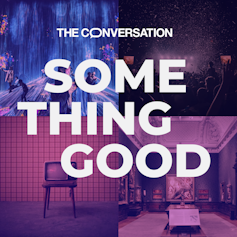Scrupulously researched and curated by fashion journalist Charlie Porter, Bring No Clothes: Bloomsbury and Fashion has opened at Charleston’s new spaces at Southover House in Lewes. The exhibition brings together original garments, paintings, photography and spoken word to explore how the Bloomsbury set continues to inspire fashion more than a century later.
Charleston was once the home and studio of the painters Vanessa Bell and Duncan Grant, and a gathering space for the artists and writers who came to be known as “the Bloomsbury set”, including Virginia Woolf and Lytton Strachey.
First, menswear designer Kim Jones transposes the works and designs of artist Duncan Grant into prints and patterns for his Dior summer 2023 collection. Jones’s hand-knitted rendering of Grant’s design for a fire curtain at Sadler’s Wells Theatre (1930) brings out all the campness of the artist, playfully reinterpreting the language of cubism to become kitsch.
Brett Lloyd
Another designer on display, Jawara Alleyne, models his work after painter Vanessa Bell’s “slapdash style of throwing clothes together” by fastening them with safety pins.
Sadly, we have no evidence of Bell’s cut-up method as we learn (from a rather matter of fact page in the diary of Charleston’s housekeeper Grace Higgens) that her clothes were burned after she died. But according to her granddaughter, historian Virginia Nicholson, Bell’s safety pins belong to the “family mythology”.
The exhibition also shows a handbag Bell made and a rags rug, still on the floors at Charleston. Repurposing and recycling clothes and cloth represented, for Bell, an ethical choice. It was an affordable alternative and a way of creating meaning through making.
What is interesting about the use of safety pins is that they not only give discarded garments a new lease, but they also mean the pieces could be dismembered again. Alleyne’s designs and installations draw out a punk attitude from Bell’s safety pins, which is lost in the representation of the Bloomsbury style as reassuring, crafty and quaint.

The Estate of Vanessa Bell
This spirit chimes with Porter’s reading of the legacy of the Bloomsbury group’s penchant for “anti-fashion: something that looks so wrong, it’s right”.
The vivacity of Bell’s self-fashioning – captured in a rarely seen portrait by Grant – shows the wildness of her eccentric colour and pattern combinations. Her sister, the writer Virginia Woolf, once rather harshly responded to her clothes designs for the Omega Workshops (a design enterprise founded by members of the Bloomsbury group) by saying they “almost wrenched my eyes from the sockets”.
Photos of Woolf from 1923 from the journal of Lady Ottoline Morrell display more fashion audacity. She pairs the floral swirls of her shawl with the lines of her dress, flaunting clash and tension in her clothing.
Under the influence of Bloomsbury
What is it about the fashion of the Bloomsbury group that continues to resonate today? In a recent examination of Bloomsbury’s experimental attitude to dress, art historian Wendy Hitchmough argued that it is their interest in a certain “bohemian latitude, and the capacity of dress to signal alternative values”.
The absence of a substantial representation of items from the Omega Workshops in this exhibition, marks its desire to move away from a history of modernist dress and instead “get closer to a garment’s wearer”.
The exhibition introduces the group’s urgent rethinking of gender, sexuality and queerness as a way of life, without downplaying the fact that in spite of their anti-colonial stance, they never examined their white entitlement. In fact, they profited from the repetition of orientalist and primitivist tropes within modernism.

Phoebe Wingrove
The Bloomsbury group’s distaste for formality helped to set the foundations for how we dress today. But it is important not to forget how this rested on some significant precedents.
The exhibition positions the members of the Bloomsbury group as standing up against the military inheritance of the three-piece suit, cinched waists and constrictive undergarments. But there is a general sense that everything vaguely late-Victorian stands for the patriarchy. This means important connections are lost with the New Women and the feminists, the vegetarians and antivivisectionists, the yogi and the sandal wearers of the previous generation. These groups paved the way for the revolution in clothing championed by the Bloomsbury set.
The sandal-wearers
One such sandal-wearer was the lesbian collector, avant-garde novelist and poet Gertrude Stein (1874-1926). Her roomy brown corduroy gown, monumentalised in a portrait by Pablo Picasso, must have made an impression on Bell. She purchased a similar dress after she visited her in 1913.
In Florence in 1904, she and Woolf had also met the writer Vernon Lee (1856-1935) whose unique look encouraged a sense of ambiguity about her gender identity. Not to mention other radically dressed figures from the era known to the group, like Radclyffe Hall, Annie Besant and Filippo De Pisis.
The modern designer Ella Boucht’s bodacious suits for queer, trans and non-binary clients – on display at the exhibition – are arguably influenced by kinship with these historical trailblazers, rather than solely, as the exhibit text says, “through opposition to the patriarchy and power within tailoring”. Sometimes queer liberation is not measured by the freedom to undress, or underdress, but its opposite.
When the Bright Young Things – a generation of gender non-conforming painted boys in London, Paris and Berlin – entered the scene in the 1920s, the meaning of the suit was completely unsettled.
By overstating the Bloomsbury set as standing alone against the conservatism of early 20th-century British society, Bring No Clothes sometimes suffers from an anxiety of influence. It is exciting to imagine the group in an agnostic relationship with history capable of inspiring posterity, but this is deaf to their dialogue with their contemporaries and predecessors.

Looking for something good? Cut through the noise with a carefully curated selection of the latest releases, live events and exhibitions, straight to your inbox every fortnight, on Fridays. Sign up here.
Credit: Source link




